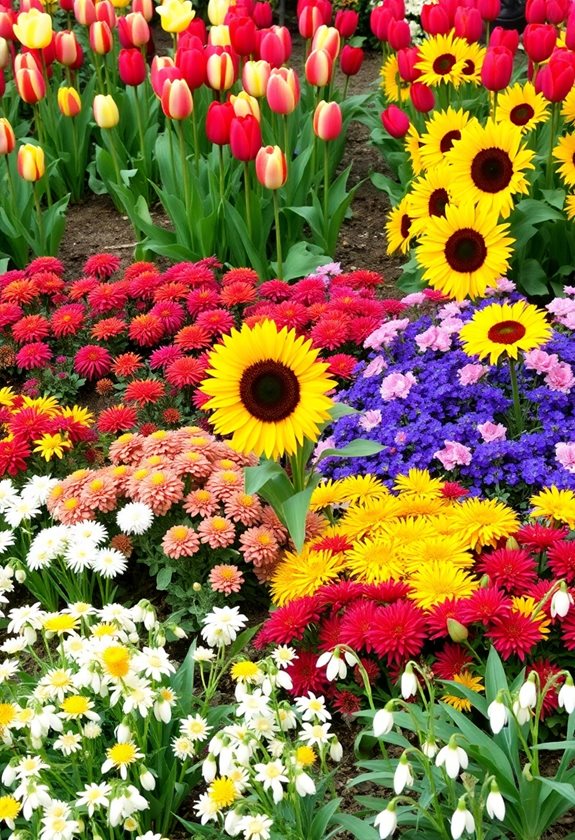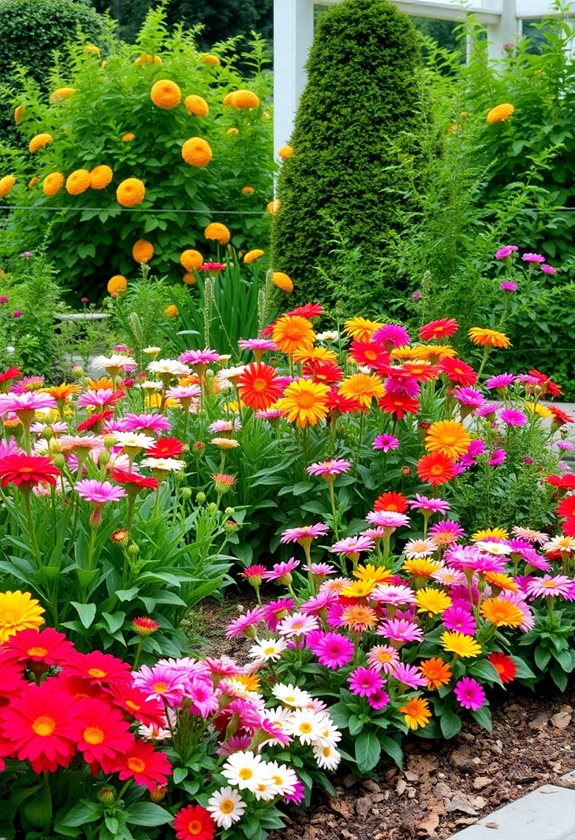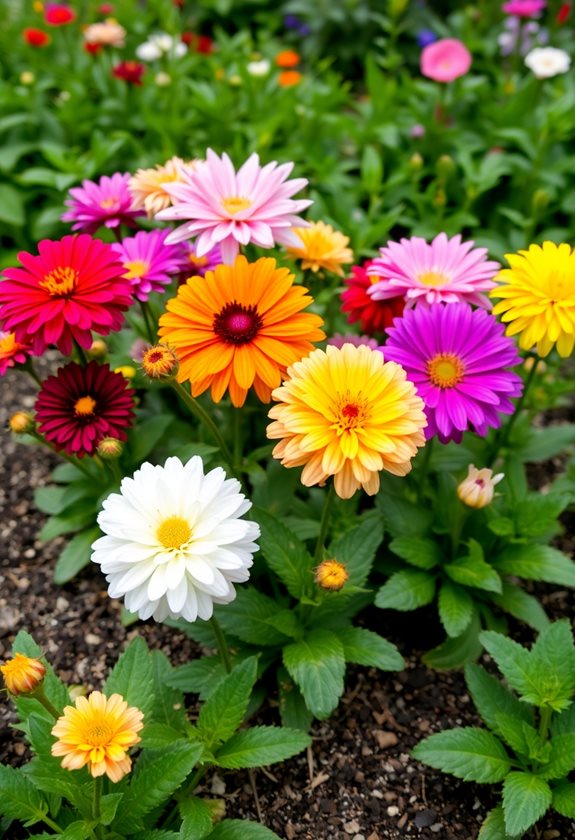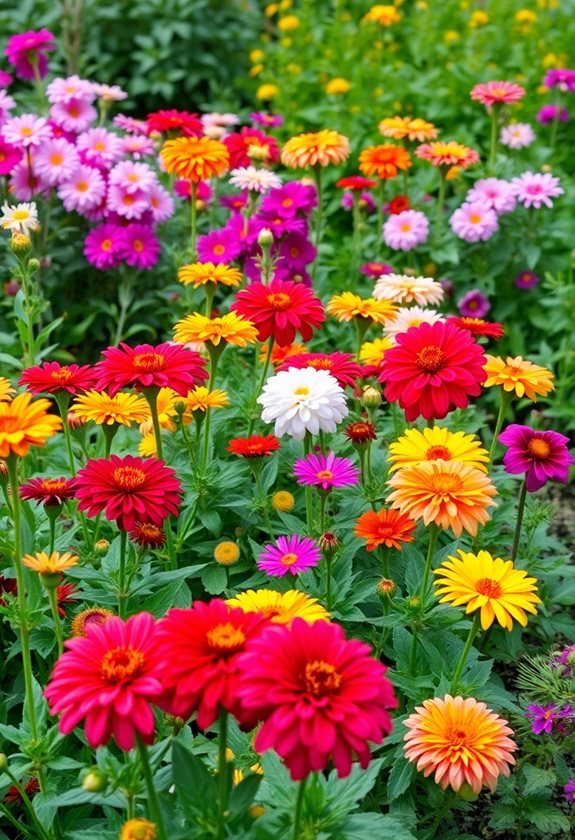Choosing flowers for year-round garden color can totally transform your outdoor space! Imagine stepping outside and seeing vibrant blooms no matter the season! Plus, they attract pollinators like bees and butterflies, making your garden alive. By mixing perennials and annuals, you can enjoy lively colors and easy maintenance. Why not layer different heights to create depth? If you’re curious about specific flower varieties and design tips to bring your garden to life, let’s dig in!
Design Highlights
- Year-round flowers provide continuous color, enhancing garden beauty and interest throughout all seasons.
- Seasonal blooms attract pollinators, supporting local ecosystems and improving garden health.
- Mixing perennials and annuals allows for both consistent returns and vibrant seasonal variety.
- Layering plant heights and incorporating varied foliage keeps the garden visually engaging year-round.
- Proper planning ensures a lively garden that adapts to seasonal changes, boosting overall mood and appreciation for nature.
The Importance of Seasonal Blooms

When you think about creating a garden that bursts with color all year round, do you ever wonder why seasonal blooms are so important? These flowers not only brighten your space but also attract pollinators, which help your garden thrive! Imagine the delight of seeing spring tulips, summer daisies, and winter pansies—each season brings its own unique charm. Plus, seasonal blooms can boost your mood! They remind you of the beauty in change. Want a colorful garden? Consider mixing early, mid, and late-season blooms for continuous interest. Vibrant seasonal flower beds can transform your outdoor space into a stunning visual masterpiece. Trust me, your garden will thank you, and so will your heart!
Planning Your Garden for Year-Round Interest

As you immerse yourself in planning your garden for year-round interest, remember that a little foresight can lead to a stunning display every season! Start by selecting flowers that bloom in different times of the year. Have you thought about layering heights? Taller plants can provide a backdrop, while shorter ones create a vibrant foreground.
Consider incorporating evergreens for winter color, and mix in bulbs for early spring surprises! Adding colorful flower beds can also enhance your garden’s appeal and attract essential pollinators.
Don’t forget about foliage—varied leaf shapes can bring interest, too. Planning ahead means you’ll enjoy a lively garden, no matter the season. Ready to dig in? Let’s get growing!
Perennials vs. Annuals: What to Choose

Deciding between perennials and annuals can feel like choosing between two of your favorite ice cream flavors—each has its own unique charm! So, how do you pick? Here’s a quick rundown to help you choose:
Choosing between perennials and annuals is like picking your favorite ice cream flavor—each brings its own delightful qualities!
- Perennials return year after year, saving you planting time.
- Annuals offer vibrant colors and variety each season.
- Perennials can be more low-maintenance in the long run.
- Annuals provide instant gratification with their quick blooms.
- Mixing both can create a dynamic garden that’s always interesting!
- Consider incorporating year-round color into your garden design for a more vibrant landscape.
Top Flower Varieties for Each Season

Creating a garden that bursts with color throughout the year is like painting a masterpiece—each season brings its own palette! For spring, try tulips and daffodils; they’re so cheerful! In summer, sunflowers and zinnias create a sunny vibe. As autumn rolls in, consider chrysanthemums and asters for rich, warm hues. Winter’s a bit trickier, but hellebores and pansies can bring a splash of color! Don’t forget to check if these flowers are safe for pets and kids. Best flowers for continuous blooming can help you maintain this vibrancy throughout the year. Which flowers will you choose to brighten your garden? With a little planning, your garden can be a year-round wonderland!
Designing a Color Palette for Your Garden

Have you ever wondered how to choose the perfect colors for your garden? Designing a color palette can be both fun and rewarding! Start by considering these five tips:
Discovering the ideal colors for your garden can be an enjoyable journey; let these tips guide your design!
- Think about your space: Are you working with sun or shade?
- Choose a dominant color: This can set the mood.
- Mix textures: Different flower shapes create interest.
- Consider seasonal changes: Plan for blooms throughout the year.
- Don’t forget the backdrop: Green foliage can enhance your colors.
In addition to these tips, selecting the best flowers for your garden can significantly elevate your design and ensure a vibrant display year-round.
Maintenance Tips for a Thriving Flower Garden

While tending to your flower garden might feel like a chore some days, it can actually be a delightful adventure that brings you closer to nature! To keep your blooms thriving, water them early in the morning—this helps prevent disease. Remove weeds regularly; they’re sneaky little devils that steal nutrients! Consider using organic fertilizers for a safe boost. And don’t forget to deadhead flowers; it encourages new growth and keeps your garden looking fresh. Have you tried companion planting? It can help with pest control! Incorporating flower companion planting combinations can also enhance the overall health of your garden. Remember, a little care goes a long way, making your flower garden a vibrant masterpiece!
Enhancing Your Garden With Foliage and Texture

Foliage can be the unsung hero of your garden, bringing life and vibrancy even when flowers take a breather. Imagine stepping outside and seeing lush greens and interesting textures! So, how can you enhance your garden with foliage?
- Choose varying leaf shapes and sizes for contrast.
- Mix colors, from deep greens to bright variegated patterns.
- Incorporate plants with different heights to create depth.
- Consider seasonal changes; some plants shine in winter!
- Don’t forget about ground covers for a soft carpet effect.
- Adding lush garden ideas can transform any small space into a vibrant retreat.
With these tips, your garden will be a safe, stunning retreat all year long!
Frequently Asked Questions
How Do I Choose Flowers Based on My Local Climate?
Choosing flowers based on your local climate can be a fun adventure! Start by checking your hardiness zone—this helps you know which plants thrive in your area. Consider sun exposure and soil type, too. For instance, if you’ve got full sun, try sunflowers or zinnias. In shaded spots, hostas and ferns shine! Don’t forget to ask local gardeners for tips—after all, who knows better than those in the know? Happy planting!
Can I Grow Flowers in Containers for Year-Round Color?
Absolutely, you can grow flowers in containers for year-round color! It’s a fantastic way to brighten your space. Just pick flowers suited to your climate. For winter, consider pansies or violas—they’re tough cookies! In spring, try petunias or marigolds. Remember to use good potting soil and guarantee your containers have drainage holes. Water regularly, but don’t drown them! Isn’t it exciting to have blooms all year? Happy planting! 🌸
What Are the Best Flowers for Attracting Pollinators?
Did you know that about 75% of the world’s flowering plants depend on pollinators? If you want to attract these busy buddies to your garden, try planting bright flowers like bee balm, lavender, and sunflowers. They’re not only beautiful but also safe for your backyard. Imagine butterflies flitting around while you sip lemonade! Keeping your garden buzzing with life is rewarding; it’s like hosting a party for nature! What’s not to love?
How Do Soil Types Affect Flower Growth and Color?
Soil types play a huge role in how your flowers grow and their color. Different flowers thrive in sandy, clay, or loamy soils. For example, if you’ve got clay, consider planting daylilies—they love it! Poor drainage can dull colors, while well-drained soil helps bring out vibrant hues. Ever wondered why your daisies look sad? It might be the soil! Test it out, and you’ll see a garden transformation! Isn’t gardening fun? 🌼
Are There Flowers That Require Minimal Maintenance Year-Round?
Absolutely, there are plenty of flowers that need minimal maintenance! For a low-key garden, consider planting:
- Daylilies: They bloom all summer and thrive on neglect.
- Sedum: These succulents are drought-resistant and add great texture.
- Black-eyed Susans: They’re hardy, vibrant, and attract butterflies!
You’ll love how easy they are to care for, giving you more time to enjoy your beautiful backyard. Who wouldn’t want a colorful garden with less work?




